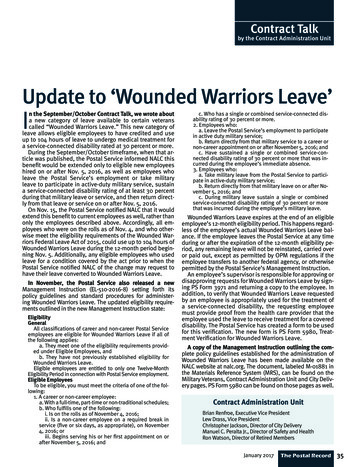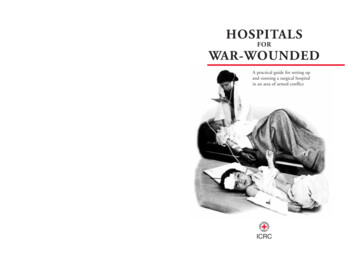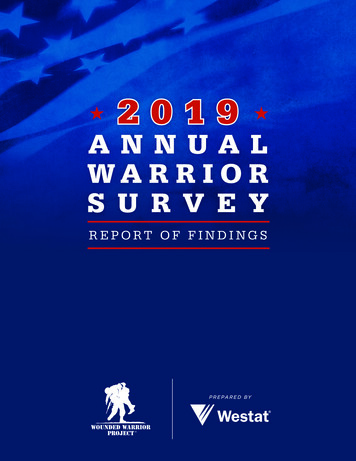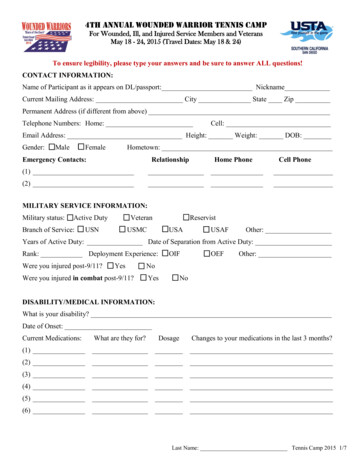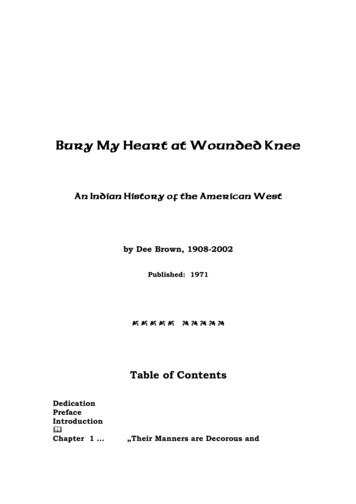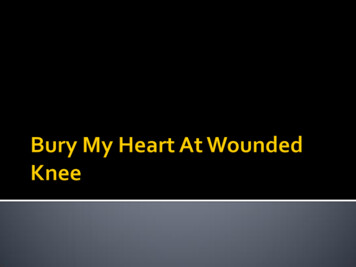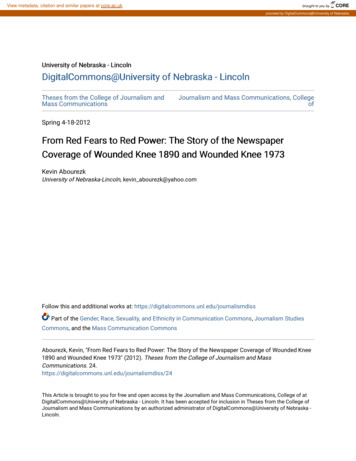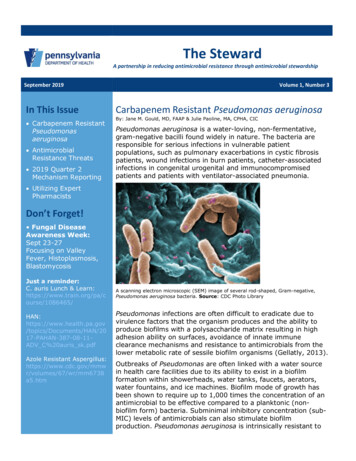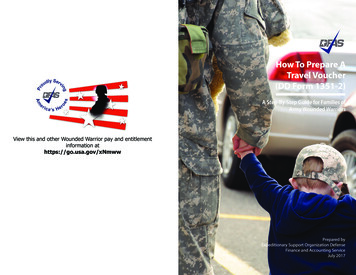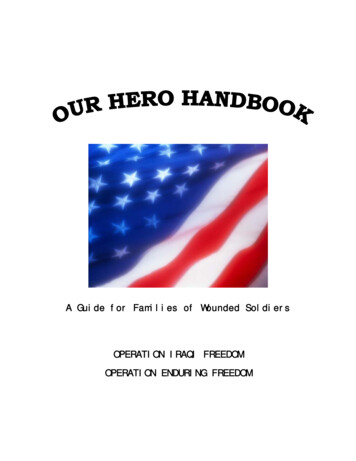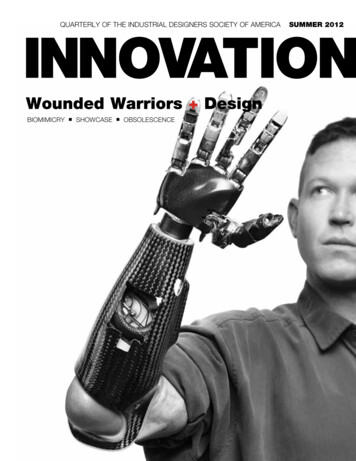
Transcription
QUARTERLY OF THE INDUSTRIAL DESIGNERS SOCIETY OF AMERICAWounded Warriors DesignbiomimicrynshowcasenobsolescenceSummer 2012
radiuspd.comsmart watchingThe e-sync watch gives you thefreedom of motion, by instantlydisplaying all notifications fromyour smartphone.Concept by Radius Senior Designer Mario Gonzalez
QUARTERLY OF THE INDUSTRIAL DESIGNERS SOCIETY OF AMERICAsUMMER 2012 PublisherRoxann HenzeIDSA555 Grove Street, Suite 200Herndon, VA 20170P: 703.707.6000 x102F: orgExecutive EditorMark Dziersk, FIDSAManaging DirectorLunar Chicagomark@lunar.comAdvisory CouncilGregg Davis, IDSAAlistair Hamilton, IDSAManaging Editor& DesignerKaren BerubeK.Designs3511 Broadrun Dr.Fairfax, VA 22033P: 703.860.4411k.designs@cox.netContributing EditorJennifer Evans YankopolusAdvertisingKatie FlegerIDSA555 Grove Street, Suite 200Herndon, VA 20170P: 703.707.6000 x104F: 703.787.8501katief@idsa.orgadvertising@idsa.org The quarterly publication of the Industrial Designers Society of America (IDSA), Innovation provides in-depth coverageof design issues and long-term trends while communicating the value of design to business and society at large.Annual SubscriptionsWithin the US 60Canada & Mexico 75International 110Single CopiesFall/YearbookAll others 35 S&H 17 S&H
Patrons of IndustrialDesign ExcellenceWOUNDED WARRIORS24 Doing It by Designby Patricia Moore, FIDSAGuest Editor26 Redesigning the GreatAmerican Pastime:Play Ball! by Jason Billingsleyand David Van Sleet28 A Rehabilitation CenterDesign Project for WoundedWarriors: Daring to Careby Vibhavari Jani32 Support from a High-TechLab—or the House NextDoor: From a MyoelectricMouse to a Hammer andNail by Stephen Karl and Julie Fisher35 Arming Our Veteransby Dean Kameninvestor48 Extreme Learning forEveryday Design: Lessonsfrom the One-Handed Worldby Kelley StyringfeaturesIDEO, Palo Alto, CA; Shanghai, China;Cambridge, MA; London, UK; San Francisco;Munich, Germany; Chicago; New YorkJerome Caruso Design Inc., Lake Forest, ILMasco, Taylor, MIProcter & Gamble, Cincinnati, OH13 Design Obsolescence:A Thing of the Past by TonyWebb deVlam Chicago, Chicago, ILKawanari, IDSA and Gabriel BotkinsCultivator16 Biomimicry & DesignEducation: Shaking Handswith a Sloth by Adelheid FischerAltitude, Somerville, MA22 Consumer Collaboration:Setting Off an IdeaStorm by Gary Grossman, IDSAIn every issue4 From the Executive Editorby Mark Dziersk, FIDSA38 The Wounded Warrior6 Business ConceptsHomes: An Agile DiscourseBetween Dualities by Ravi Sawhney, FIDSAby Altay Sendil and Hilary Hoeber8 Letters to the Editor10 Design Defined42 An In-Depth Lookby Scott Summitby Michael Graves & Associates12 Book Review45 An Inclusive Consumerby Scott Stropkay, IDSAResearch Perspective:53 ShowcaseComing Home64 Signpostsby Brian McMahon and Joyce Chungby Alistair Hamilton, IDSACesaroni Design Associates Inc., Glenview, ILContinuum, Boston; Los Angeles; Milan, Italy;Seoul, South Korea; Shanghai, ChinaCrown Equipment, New Bremen, OHDell, Round Rock, TXDesign Concepts, Madison, WIEastman Chemical Co., Kingsport, TNHewlett-Packard, Palo Alto, CAIDI/Innovations & Development Inc.,Edgewater, NJLunar Design Inc., Palo Alto, CAMetaphase Design Group Inc., St. Louis, MONokia Design, Calabasas, CASmart Design, New York; San Francisco;Barcelona, SpainStanley Black & Decker, New Britain, CTTeague, Seattle, WATupperware, WorldwideCharter Patrons indicated by color.For more information about becoming a“The Wounded Warrior Complex helps injured combat veteransto find independence and new hope.”Patron and supporting IDSA’s communicationand education outreach, please contactDawn Hatzer at 703.707.6000 x119.Wounded Warrior Complex, Camp Pendleton, CA (left) designed byParron Hall Office Interiors for US Marine Corps; www.dirtt.netQUarTerly oF The inDUsTrial DesiGners socieTy oF americaSummer 2012Cover photo: Marine Captain and Iraqi Vet Jonathan Kuniholm wearing a prototype ofINNOVATIONa neurally controlled prosthetic arm developed by the DARPA Revolutionizing Prothesticsproject. Mike McGregor / Contour by Getty ImagesWOuNDeD WArrIOrS DeSIgNWounded Warriors DesignbiomimicrynshowcasenobsolescenceSummer 2012Innovation is the quarterly journal of the Industrial Designers Society of America (IDSA), theprofessional organization serving the needs of US industrial designers. Reproduction inwhole or in part—in any form—without the written permission of the publisher is prohibited.The opinions expressed in the bylined articles are those of the writers and not necessarilythose of IDSA. IDSA reserves the right to decline any advertisement that is contrary to themission, goals and guiding principles of the Society. The appearance of an ad does notconstitute an endorsement by IDSA. All design and photo credits are listed as providedby the submitter. Innovation is printed on recycled paper with soy-based inks. The use ofIDSA and FIDSA after a name is a registered collective membership mark. Innovation (ISSNNo. 0731-2334 and USPS No. 0016-067) is published quarterly by the Industrial DesignersSociety of America (IDSA)/Innovation, 555 Grove Street, Suite 200, Herndon, VA 20170.Periodical postage at Sterling, VA 20164 and at additional mailing offices. POSTMASTER:Send address changes to IDSA/Innovation, 555 Grove Street, Suite 200, Herndon, VA20170, USA. 2012 Industrial Designers Society of America. Vol. 31, No. 2, 2012; Libraryof Congress Catalog No. 82-640971; ISSN No. 0731-2334; USPS 0016-067.Advertisers’ Indexc371c48c292012 IDSA ConferenceConwedLaFrance Corp.LunarMIT PressRadius PDStratyasysFar Left: More Showcase submissions on page 53.
48w w w . I N N O V A T I O N j o u r na l . o r g
nBy Kelley Styringwww.theonehandedworld.blogspot.comConsumer strategist Kelley Styring is a Procter & Gamble and Frito-Lay market-research veteran whose firm, InsightFarm,consults with Fortune 100 companies. Styring (née Schofield) interned at Black & Decker with Carroll Gantz, FIDSA, whileearning a degree in industrial design from the University of the Arts in Philadelphia under Dr. Noel Mayo, IDSA.Extreme Learning for Everyday DesignLessons from theOne-Handed WorldIn the world of market research, studying extreme populations isn’t a popular idea. The problem, we’retold, is that the extreme populations are too small and difficult to find (i.e., expensive) and that we can’textrapolate our findings to the general population (i.e., not profitable). I don’t believe this.As a researcher for Procter & Gamble, I traveled around theworld learning how different people diaper their babies sothat the company could design, produce and market betterdiapers. As part of that, I studied what I consider to be anextreme population: mothers of triplets. As a mother myself,I know that having one baby is challenging. Having three?Yikes. But I found that these mothers of multiples becomeextremely efficient and develop shortcuts that are helpfulfor all mothers. That’s because they learn to improviseand make products work that weren’t designed for theirparticular situation. We call this a compensatory behavior,one critical element in identifying next-generation products.And do you remember the metrosexuals, those men inthe 1990s who were deeply invested in personal groomingand used products made for women? Another extremepopulation studied. As a result, beauty-care companieswere inspired to create an entirely new category of skincareand styling products aimed at men, an entirely new market.Today, some very manly sports figures are pitchmen formen’s grooming products, made by companies that usedto only make products for women.So when I became intrigued by the dramatic rise insmartphone usage, I started to think about one-handedness. My own experiences include failures like droppingmy cellphone into an open cup of latte while driving and triumphs like opening, applying and successfully recapping alipstick—all one-handed—during a telephone conversation.People have been multitasking for years, but I wondered: Isthe constant use of the handheld mobile device changing us? And if so, what are the implications for consumerproducts and packaging? How to find out?Photos: John C. Thomas, FisheyeINNOVATION summer 201249
wounded wa r r io r sThen it hit me: Who better to teach us about living ina one-handed world than the ultimate extreme population?Arm amputees live elegantly and efficiently with only onehand, every day. By understanding the challenges of livingin the one-handed world, I could discover some of the solutions and compensatory behaviors as well. And that couldlead us to design and create better products and packagesfor everyone.Illustration: Geoff Marko, Brandhouse Inc.Indeed, while studying an extreme population canprovide insights that can benefit all consumers, in the OneHanded World study I found that it could take us a step further. While most market research captures the consumers’past, this study provides us with a very rare glimpse into theconsumers’ future—in a word, providing us with foresight.With this study, smart designers have the opportunity notonly to understand where consumers are headed in thefuture but also to get there first with new designs to meetthe consumers’ new needs.My career as a designer both led me down the path tobecoming a market researcher and informed my consumerstrategy practice. At Black & Decker, and later as a humanfactors designer at NASA, I discovered that my design workwas always enhanced by people called market researchers.More recently, I have found that being a designer has mademe a better researcher. My role is to inspire creativity andinnovation on behalf of the consumer and help companiesnot just see their products and services as they are, but toreimagine them as they could be.50w w w . I N N O V A T I O N j o u r na l . o r g
Logo: Mark HilvertFascinating FindingsOne of the greatest barriers to studying extreme populations in the past was how difficult it was to simply find andrecruit them. Reaching arm amputees, while not a simpleeffort, was made much more feasible through technologyand social networks. Leveraging one contact to create three,InsightFarm was able to tap into an insular population andbuild the relationships needed to gain access and collectinformation. Within a year, we created a community of amputees willing to participate in the One Handed World study.Participants reported how they interacted with andwere challenged by nearly 250 everyday products andpackages across 18 different categories, along with specificmoments of interaction that are difficult and the reasonsthey are difficult. The same measurements were madeamong the two-handed population for comparison, alongwith questions about how they spend their days. Theresults were surprising.Overall, one-quarter of amputee respondents foundeveryday products difficult to operate with one hand, withthe degree of difficulty increasing with the complexity ofthe task. I was stunned at the number of products thattwo-handed consumers reported difficulty opening orusing—even when both hands were fully available. And theyreported difficulties in the majority of the same categories asthe one-handed consumers, which means the issue isn’twith the consumer, it’s with the product or the package.Additionally, I discovered that two-handed consumersnow spend the majority of their waking hours, 40 percent,with one hand occupied. As a result, they attempt to interact with a variety of other products and packages using asingle hand or finger. While multitasking itself isn’t a newactivity, the dramatic surge in the use of handheld technology is driving a permanent change in human behavior. Thecellphone was identified as the second most common itemoccupying the hand, behind only carrying things.Basically, we are living in a one-handed world. Peopleare on the go and trying to get more done in less time, sothey desperately need products and packages designed toaccommodate that lifestyle. The One Handed World studyhas found that one-handed convenience creates delightand engenders loyalty in consumers. A product that is easyto use with a single available hand creates a tremendouscompetitive advantage for itself in the marketplace. It is alsoan opportunity to boost profits, since consumers will pay apremium for convenience.Reimagine the OrdinaryIt is time for products and packaging to change. This imperative isn’t about specialized high-tech gadgets or 100shoelaces for amputees. In fact, it is even more importantfor low-tech products. Items people use every day—adhesive bandages, ketchup packets, tape, yogurt cups, cerealboxes and more—could greatly differentiate themselvesfrom competitors by being easier to use with one hand.This concept is actually different from universal design,which provides access to everyday products and packagesfor those with special needs. Interestingly, this study sug-INNOVATION summer 201251
Most Difficult Categories of Products to Open or UseOne-Handed ConsumersTwo-Handed ConsumersRank1234568910CategoryToolsOther FoodsHealth/MedicalPackage TypesSnacksCooking and l CarePercent yToolsHealth/MedicalPackage TypesCooking and EatingApparelSnacksSports/RecreationOther FoodsBeveragesPersonal CarePercent58%48%44%44%42%37%36%33%33%27%Of the top ten categories identified as most difficult, nine of them were identical between one-handed and two-handed people. According to the research,that means the issue isn’t with the consumer, it’s with the item they are trying to open or use.gests that arm amputees are actually more capable thantwo-handed people in this emerging one-handed world and,as such, lead the way to the future of product and packagedesign for everyone. Certainly not what one would expectfrom a study of an extreme population.Those of us with two hands are constrained by our ownexperience, since we’ve never had to think about how wewould open a package or use an item with only one hand.We assume that two hands will be available. Studying thisextreme population provides the knowledge—the foresight—that allows designers to do what they do best:step outside reality and truly experience another perspective in order to reimagine the ordinary.I experienced this at NASA. For the first time, we hadto account for women as flight controllers. It became anincredible challenge because women presented totally different human factors. It required those of us designing (eventhe women) to change our perspective so as to meet theneeds of everyone.A Place to FishI grew up in Florida, and we fished a lot. Now, there’s a lotof ocean out there, so how can you be most efficient at finding the fish? Well, you look for the birds. The birds eat thelittle fish, so they follow them. The little fish are also eatenby the big fish, so find the birds and you’ve found the bestplace to find the big fish. It’s the same with ideas. You needto find a place that’s rich with the opportunity to help youcatch the big ones.While hands-free remains the gold standard for ease ofuse with our extreme population, that’s not always possible.52w w w . I N N O V A T I O N j o u r na l . o r gThe One Handed World study has developed 17 differentinnovation platforms designers can use to create or improvetheir products or packaging. For example:nOne-handed stabilization and manipulation: Thisplatform identifies products that require one hand to dotwo different jobs: stabilize an item and manipulate it atthe same time, such as opening a jar. Can the palm beused to stabilize an item while the fingers or thumb ofthe same hand open it?nToothiness: Much to dentists’ dismay, the third handis often the teeth. While it may be unsafe and sociallyunacceptable, teeth are being used to compensate forpackages that are difficult to open. Designing packages to be opened safely and hygienically with theteeth would be paradigm-breaking, rather than incisorbreaking, for consumers.nAir as a propellant: What if air could be used to loosenor open a package, especially something that currentlycauses such difficulty for so many consumers, likecereal boxes?nPackages with predictable opening results: Itdoesn’t matter how many hands you have available touse if you can’t count on a particular package to openin exactly the same way twice. Consistency countswith, and creates delight in, consumers.In essence, it’s all about facilitating usage, whether the useris an amputee, a college student on a smartphone or a busymom trying to hang onto a toddler’s hand. And thanks tothe extreme users in the one-handed world, we can designa new future that makes life easier for everyone. n
FUTUREIS.THEIDSA 2012 INTERNATIONAL CONFERENCE . BOSTON 8.15.12 . PEOPLE TECHNOLOGY BUSINESSRegister Now.LAURENCE GARTELSYD MEADLESLEY MOTTLASTEFAN ANDRENTOM DIERKINGSAM AQUILLANODEREK CASCIOVALERIE FLETCHERBOB SCHWARTZDAVID WALLACEKUNPYO LEEHARRY WESTTED ACWORTHMIKE&MAAIKENATE BALLSnap to register or visit:www.idsa.org/thefutureis@idsaboston2012
WINNER.L U N A R . C O MLUNAR ’S J UNGGI SUNGW I N N E R O F FA S T CO M PA N Y ’ S P O R S C H E D E S I G N C H A L L E N G E .
ative isn't about specialized high-tech gadgets or 100 shoelaces for amputees. In fact, it is even more important for low-tech products. Items people use every day—adhe-sive bandages, ketchup packets, tape, yogurt cups, cereal boxes and more—could greatly differentiate themselves from competitors by being easier to use with one hand.
